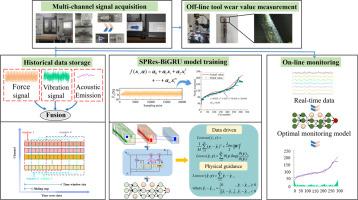A dual knowledge embedded hybrid model based on augmented data and improved loss function for tool wear monitoring
IF 9.1
1区 计算机科学
Q1 COMPUTER SCIENCE, INTERDISCIPLINARY APPLICATIONS
引用次数: 0
Abstract
Tool wear monitoring (TWM) is essential for enhancing the machining accuracy of intelligent manufacturing systems and ensuring the consistency and reliability of products. The complex and dynamic processing environment demands higher real-time monitoring and generalization ability of TWM. Traditional data-driven models lack guided training in physical processes and are limited by the amount of samples with wear labels. To guide the model to capture the underlying physical mechanism and enhance compliance with the law of tool wear, a dual knowledge embedded hybrid model based on augmented data and improved loss function for TWM is proposed in this paper. The second training data source is obtained by constructing the mapping relationship between cutting force and tool wear, which effectively complements and enhances the physical characteristics between the data and addresses the issue of insufficient labeled data in actual network training. Subsequently, a structure integrating serial convolution, parallel convolution, bidirectional gated recurrent unit (BiGRU) and attention mechanism is developed to extract the spatial and temporal features in time series data. Moreover, Based on the physical law of tool wear, an improved loss function with physical constraints is proposed to improve the physical consistency of the model. The experimental results show that the model prediction RMSE error is reduced by 12.67% after augmented data compared to a single data source, and the RMSE error of the prediction result is reduced by 25.16% at most after the improvement of the loss function. The model has high prediction accuracy within short training epochs and good real-time performance. The proposed approach provides a modeling strategy with low computational resource requirements based on the fusion of physical and data information.

基于增强数据和改进损失函数的双知识嵌入式混合模型,用于刀具磨损监测
刀具磨损监测(TWM)对于提高智能制造系统的加工精度、确保产品的一致性和可靠性至关重要。复杂多变的加工环境要求 TWM 具有更高的实时监控和概括能力。传统的数据驱动模型缺乏对物理过程的指导性训练,并且受到带有磨损标签的样本量的限制。为了引导模型捕捉潜在的物理机制并增强对刀具磨损规律的遵从,本文提出了一种基于增强数据和改进损失函数的双知识嵌入式混合模型,用于 TWM。通过构建切削力与刀具磨损之间的映射关系获得第二训练数据源,有效补充和增强了数据之间的物理特性,解决了实际网络训练中标注数据不足的问题。随后,开发了集串行卷积、并行卷积、双向门控递归单元(BiGRU)和注意力机制于一体的结构,以提取时间序列数据的时空特征。此外,根据刀具磨损的物理规律,提出了一种带有物理约束的改进损失函数,以提高模型的物理一致性。实验结果表明,与单一数据源相比,增强数据后的模型预测均方根误差降低了 12.67%,损失函数改进后的预测结果均方根误差最多降低了 25.16%。该模型在较短的训练历时内具有较高的预测精度和良好的实时性。所提出的方法提供了一种基于物理信息和数据信息融合的低计算资源需求建模策略。
本文章由计算机程序翻译,如有差异,请以英文原文为准。
求助全文
约1分钟内获得全文
求助全文
来源期刊
CiteScore
24.10
自引率
13.50%
发文量
160
审稿时长
50 days
期刊介绍:
The journal, Robotics and Computer-Integrated Manufacturing, focuses on sharing research applications that contribute to the development of new or enhanced robotics, manufacturing technologies, and innovative manufacturing strategies that are relevant to industry. Papers that combine theory and experimental validation are preferred, while review papers on current robotics and manufacturing issues are also considered. However, papers on traditional machining processes, modeling and simulation, supply chain management, and resource optimization are generally not within the scope of the journal, as there are more appropriate journals for these topics. Similarly, papers that are overly theoretical or mathematical will be directed to other suitable journals. The journal welcomes original papers in areas such as industrial robotics, human-robot collaboration in manufacturing, cloud-based manufacturing, cyber-physical production systems, big data analytics in manufacturing, smart mechatronics, machine learning, adaptive and sustainable manufacturing, and other fields involving unique manufacturing technologies.

 求助内容:
求助内容: 应助结果提醒方式:
应助结果提醒方式:


